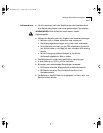
Using the Command-Line Interface C-5
VLAN Names:
There are restrictions on VLAN names. They cannot contain white
spaces and cannot start with a numeric value unless you use quotation
marks around the name. If a name contains white spaces or starts with
a numeric, you must use quotation marks whenever referring to the
VLAN name.
802.1Q links do not work correctly:
Remember that VLAN names are only locally significant through the
command line interface. In order for two switches to communicate
across a 802.1Q link, the VLANid for the VLAN on one switch should
have a corresponding VLANid for the VLAN on the other switch.
If you are connecting to a third-party device and have checked that the
VLANids are the same, the Ethertype field used to identify packets as
802.1Q packets may differ between the devices. The default value used
by the switch is 8100. If the third party device differs from this and
cannot be changed, you may change the 802.1Q Ethertype used by the
switch with the command:
config dot1p ethertype <ethertype>
Changing this parameter will change how the switch recognizes all
tagged frames received and the value it inserts in all tagged frames it
transmits.
VLANs, IP Addresses and default routes:
Recall that the switch can have an IP address for each configured
VLAN. It is only necessary to have an IP address associated with a VLAN
if you intend to manage (telnet, SNMP, ping) through that VLAN. You
can also configure multiple default routes for the switch. The switch
will try first, the default route with the lowest cost metric.
STP You have connected an endstation directly to the Switch and the
endstation fails to boot correctly:
The Switch has STP enabled, and the endstation is booting before the
STP initialization process is complete. Specify STP has been disabled,
and then reboot the endstation.
SW3800.BK Page 5 Tuesday, May 5, 1998 5:20 PM


















